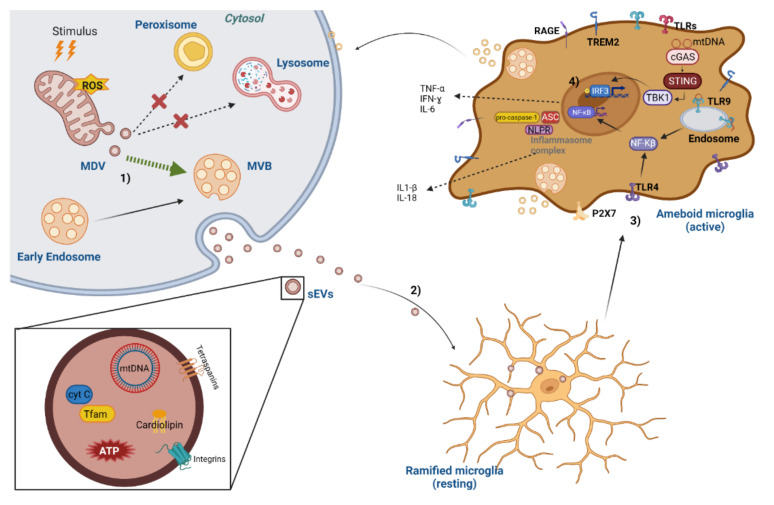Figure 2.
Molecular mechanisms of EV-associated DAMPs-mediated neuroinflammation. (1) After an oxidative stimulus, increased levels of reactive oxygen species (ROS) lead to generation of mitochondrial-derived vesicles (MDVs). The process of MDV production can result in delivering oxidised proteins to peroxisome/lysosome degradation or routing them to the multivesicular bodies (MVBs), which will be released as extracellular vesicles (EVs). Several mitochondrial components can be released within MDVs, including mtDNA, cardiolipin, cytochrome C, mitochondrial transcription factor A (TFAM) and N-formyl peptides, which are considered as mitochondrial damage-associated molecular patterns (DAMPs). (2) Mitochondrial DAMPs in EVs can initiate a microglia pro-inflammatory immune response by inducing a conformational change from a normal ramified morphology (resting) to an ameboid form (activated). (3) Mitochondrial DAMPs interact with pattern recognition receptors that include the Toll-like receptor (TLR) family (TLR1 to TLR10). MtDNA can activate a neuroinflammatory response by triggering interferon genes, TLR9 (membrane of the endosome) and the NLRP3 inflammasome. MtDNA can elicit a downstream signalling cascade which activates MAPK and the nuclear transcription factor NF-κB. MtDNA can also activate the NLRP3 inflammasome and through the caspase-1 activation promote the expression of IL-18 and IL-1β. (4) MtDNA is also detected by cGAS, that further binds to STING activating TBK1. The activation of TBK1 leads to IRF3 phosphorylation, translocation into the nucleus and consequent induction of various IFN-stimulated genes. TBK1 also activates the NF-κB signalling pathway, thus increasing the expression of IL-6 and TNF-α, contributing to chronic neuroinflammation and accelerating neuron degeneration. Abbreviations: ATP—adenosine triphosphate; cyt C—cytochrome C; MBVs—multivesicular bodies; MDV—mitochondrial-derived vesicle; mtDNA—mitochondrial deoxynucleic acid; NLPR—NOD-like receptor; RAGE—receptor for advanced glycation end-products; ROS—reactive oxygen species; TFAM—mitochondrial transcription factor A; TLRs—Toll-like receptors; TREM2—triggering receptor expressed on myeloid cells 2; STING—stimulator of interferon genes; TBK1—protein kinase tank-binding kinase 1; IRF3—interferon regulatory factor 3. Created with BioRender.com; accessed on 12 June 2022.

